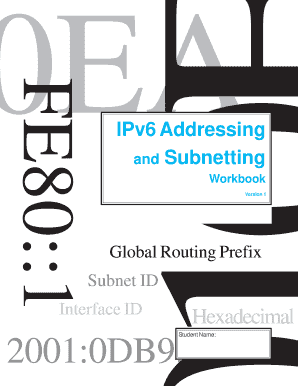
Get Ipv6 Addressing And Subnetting Workbook 2020-2025
How it works
-
Open form follow the instructions
-
Easily sign the form with your finger
-
Send filled & signed form or save
How to use or fill out the IPV6 Addressing and Subnetting Workbook online
This guide provides users with straightforward and detailed instructions on how to complete the IPV6 Addressing and Subnetting Workbook online. It is structured to assist users at all levels of experience as they navigate through the workbook effectively.
Follow the steps to fill out the IPV6 Addressing and Subnetting Workbook online.
- Click the ‘Get Form’ button to obtain the workbook and open it in a supported digital environment.
- Locate the 'Student Name' field and input your full name, ensuring that it is clearly written for identification purposes.
- In the section labeled 'Global Routing Prefix,' input the relevant address prefix you have been assigned, following the format provided.
- Find the 'Subnet ID' field and enter the subnet ID that corresponds to your specific network setup.
- For the 'Interface ID,' enter the specific individual identifier that will be used for the interface, following the conventions described in the workbook.
- Refer to the section detailing types of IPV6 addresses and ensure the types applicable to your entries are marked accordingly.
- Complete any subnetting problems included in the workbook by clearly writing or entering each response as asked, maintaining proper format.
- Review your entries for accuracy before finalizing the document.
- Once completed, you can save your changes, download the document, print it, or share it as needed.
Start filling out the IPV6 Addressing and Subnetting Workbook online to enhance your understanding and management of IPV6 addressing.
Related links form
Configuring IPv4 and IPv6 addressing involves setting up networking equipment to support both address formats. You should begin by defining the addressing scheme, including subnets and device assignments. Familiarizing yourself with the differences between IPv4 and IPv6 is key to effective configuration. For detailed guidance, refer to the IPv6 Addressing And Subnetting Workbook, which covers both addressing types.
Industry-leading security and compliance
-
In businnes since 199725+ years providing professional legal documents.
-
Accredited businessGuarantees that a business meets BBB accreditation standards in the US and Canada.
-
Secured by BraintreeValidated Level 1 PCI DSS compliant payment gateway that accepts most major credit and debit card brands from across the globe.


